Bush Babies: Tomorrow's Predators in the Making ...
The higher up the food chain, the less you get eaten. Or is this a fact? The apex predators need to reproduce safely to play their vital role in this intricate balance of nature. With a race against time and the constant pressure to survive against the odds; only some will be lucky enough to make it to adulthood. Often, the young of one species will be killed and eaten by other predators. Or even by others of the same species. It's a jungle out there.
It's quite remarkable how each of these predator species has its own fascinating way of mating, birthing and rearing its young.
Lion Cubs
Lionesses will leave the pride and find a secret hideaway where they can give birth and look after their cubs for a month or two before returning to the pride and introducing their young to them. Generally, she'll give birth to two or three cubs, however, litters of up to six cubs have been recorded.
Her young are born the typical tawny colour of lion, yet with noticeable spots which gradually fade as they grow up. The cubs are born blind, much like kittens, only opening their eyes when they're a few days old. They also only learn to walk at around two weeks old so they're literally helpless, and the mother works hard to keep them safe at this vulnerable time.
She'll start weaning them from about 10 weeks and they're usually fully weaned by about six months. Lactating lionesses of the same pride will sometimes feed each other's cubs. The cubs will begin to eat meat at around three months.
Despite enjoying the protection of the males in the pride, the cubs learn all their hunting and life skills from their mothers, usually becoming accomplished hunters by age two and fully grown adults by four.
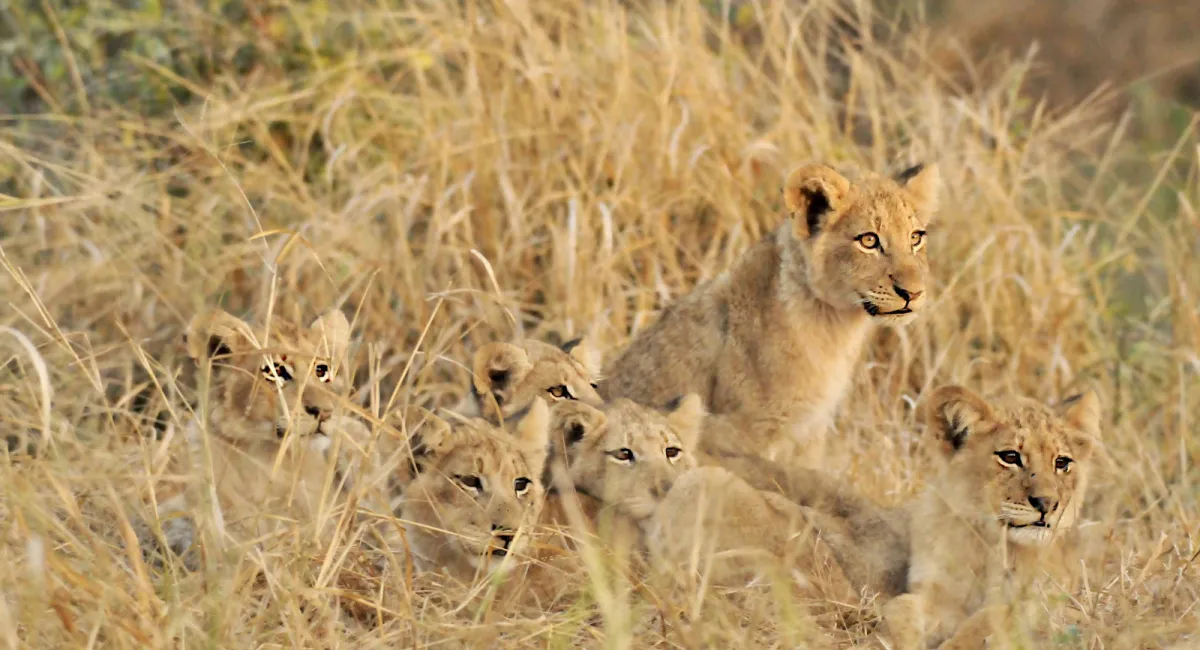
Lion cubs waiting in the long grass for their mothers to return.
Female lions will remain with the same pride for life. The young males either leave or are chased off by the adult males when they're around two to three years old. These young lions often stay together with their brothers or cousins in small groups as they have a far greater chance of survival this way. Once fully mature, they may try to take over their own pride, usually killing off all the young cubs sired by other males to ensure the continuation of their own gene pool. Life is tough for a young lion.
Wild Dogs
Unlike lion prides, wild dog packs have an alpha breeding pair that is responsible for reproducing, which helps to keep the pack at a manageable size.
The female will 'disappear' for a while into a den or underground hole (like a former warthog burrow). Both the males and females of the pack will help with raising the pups who start to wean at around 14 days. When the pack goes out to hunt, some of the adults will remain behind to take care of the puppies. After a successful hunt, the dogs will regurgitate the meat and feed the puppies first. Wild dogs are highly successful, rapid hunters that can bring down an adult kudu bull and strip it of its flesh in under 15 minutes – around 100 kg of meat!
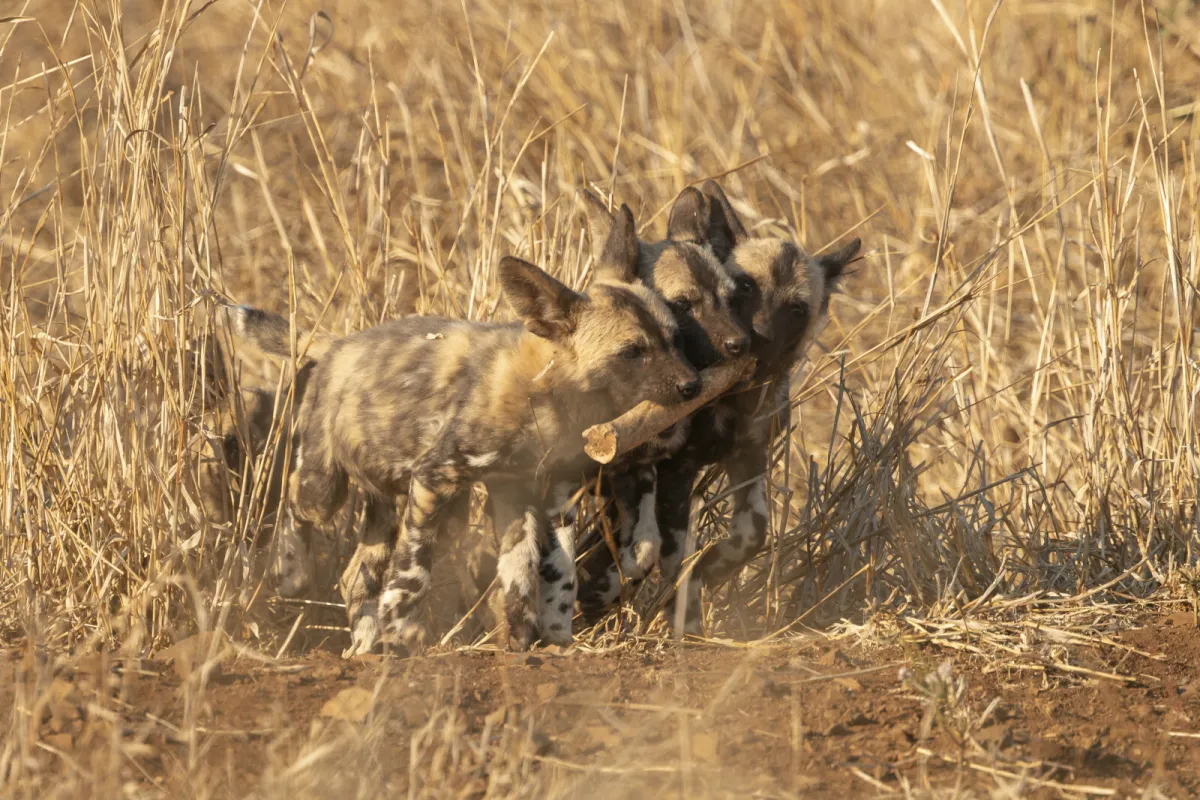
African wild dog pups fighting over a stick.
Unlike lions, adult African wild dog males usually remain with the pack for life. It's the young females who leave the family pack when they're around two to three years old to search out new packs with a shortage of females. The pups are most at risk during their first few weeks when any other big predator that finds the den site will kill the pups if they can get to them.
Cheetah
Cheetah mothers usually give birth to litters of one to six cubs after a gestation period of three months. The cubs' biggest threat is lion; in some areas of East Africa, it is said that they kill some 70% of the cubs with as few as 5% making it successfully to adulthood.
As with lion, the cubs are born blind and helpless and hidden away in thickets by their mother, who may often move them to new hiding places to try and keep them safe from other predators like hyena and leopard.
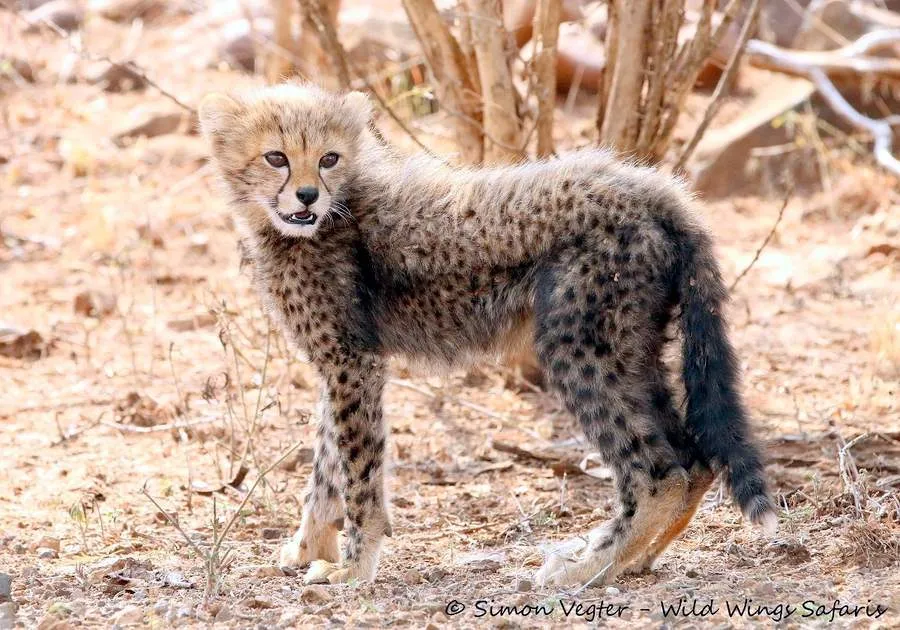
Fluffy cheetah cub.
Cheetah cubs are born with darkish, long fur which is thought to make them appear bigger and protect them from predation. They are weaned at around three months and start eating meat at around six weeks. The mother will teach them to successfully hunt by around six months. Female cheetahs are generally solitary but will keep their cubs until they are independent hunters, usually before 18 months.
Male cheetah, usually brothers, will often live together in small groups of three or four, known as coalitions. They remain vulnerable to being killed by lions, even as adults.
Hyena
Hyena packs are run by a dominant female, the matriarch. Unusually, female hyenas are larger than their male counterparts. Pups get preference in the pack so males are the underdogs. Pups assume the status of their mothers – the alpha female gets the best feeding, sleeping, mating opportunities and den sites. The mating privilege is usually given to the highest-ranking male visitor, not by the resident males which have the lowest social status.
Hyena have litters of up to four pups, also in dens which can be underground burrows or caves. Unlike lion and cheetah, the pups are born sighted with well-developed teeth. They are only weaned at around 14 months and live solely on mother's milk for their first six to nine months. Competition between the pups is fierce. The strongest will get the most milk, and even the adults will bully the younger, weaker pups and prevent them from feeding.
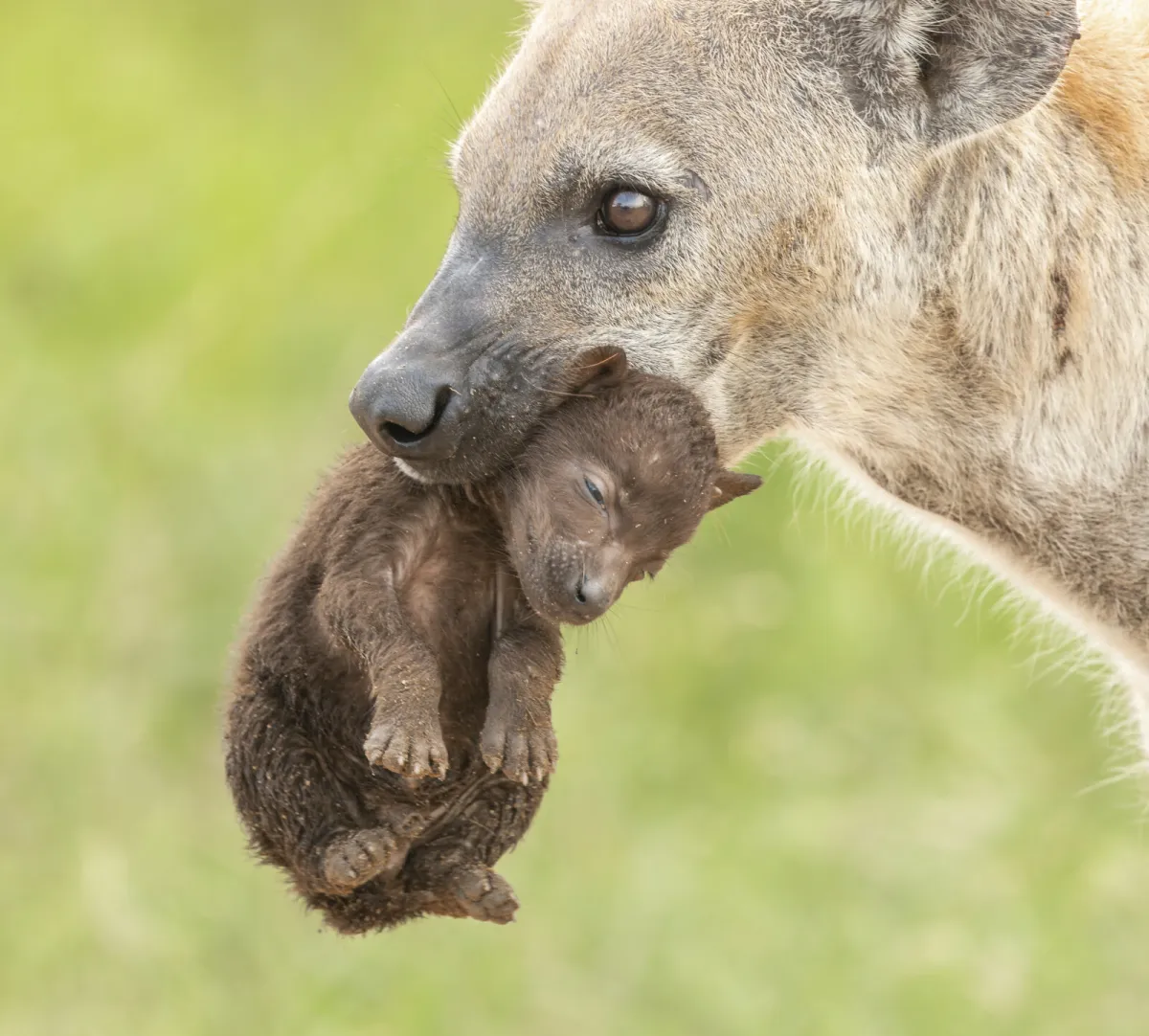
Hyena pup.
Although often maligned as simply scavengers, hyena are skilful hunters in their own right. In the Kruger National Park, they kill approximately 50% of their own prey and in other areas like Kalahari and Chobe, they're said to kill between 70 and 80%. Their strength lies in their pack. A large pack of hyenas can be a real threat even to a small pride of lions. Lions and hyenas are known to be "eternal enemies", which is also the title of a famous documentary about their rivalry.
Leopard
Although the most common and the most successful of the large cats, they're also the shyest and most elusive and are very difficult to spot in the wild. They often hide in trees, on rocky outcrops and are more active at night. Incredibly powerful and agile, they can hoist a carcass of over 50 kg up high into a tree where they'll feed off it for days.
Leopards are solitary and territorial by nature, only meeting up to mate. Their gestation period is around 10 weeks and their cubs are also born blind and helpless, so mothers will carefully choose a hidden birthing place in caves or deep thickets. Litters are usually two to three cubs and their coats are initially greyer, perhaps to help with camouflage against predators.
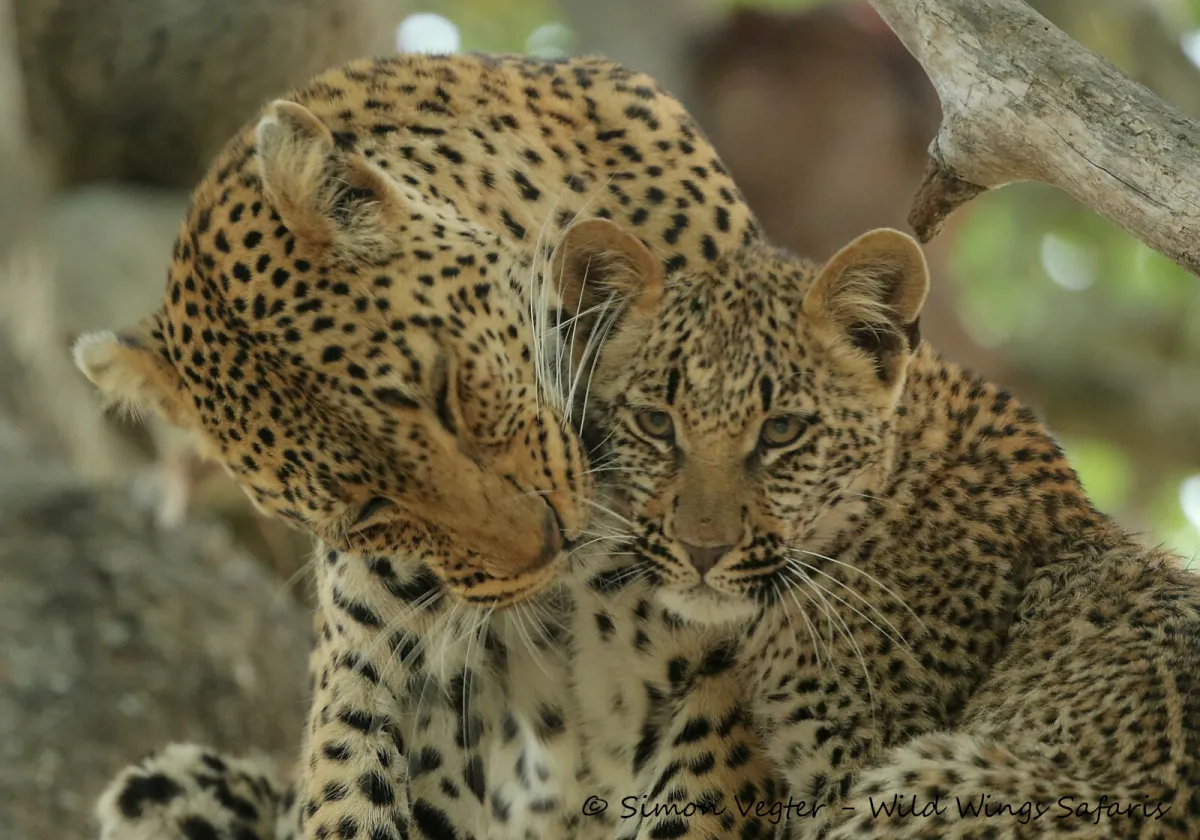
Female leopard and cub.
They suckle for up to three months or more before starting to accompany their mother on hunts (around four months); usually making their first kills before they're six months old. A female leopard will keep her cubs with her until they are skilled hunters and able to be independent, usually around 18 months. Leopard cubs are at risk of being killed by lions, hyenas and even baboons.
A Word About Predator Cub Interaction
Over the last few years, more and more cub petting facilities – particularly lion cubs - have sprung up at local lion parks and rehabilitation centres.
The attraction is irresistible to many tourists who are able to stroke and pick up these babies, with wonderful photographic opportunities.
However, it must be stressed that most of these facilities have been directly linked to the canned lion hunting industry. Nature is nature and wild animals are wild animals. By making lion, leopard, cheetah and other predator cubs used to being handled by and in close contact with humans, they lose their natural fear of man and ability to fend for themselves in the wild.
Please be aware that that adorable cub you get to pet and handle is in all likelihood destined to be hunted as an adult in captivity, with very unfavourable odds, by high-paying trophy hunters armed with guns, crossbows and the like.
It has also been proven that some of these canned hunting 'farmers' lease these lion cubs – often taken away from their mothers far too young – to these attractions to help pay for their upkeep until they are old enough to be hunted and bring in serious money. As a safari company, we would much rather show you a wild lion cub or cheetah cub in its natural habitat than take you to a big cat interaction facility where you can touch lion cubs or cheetah cubs in captivity.
You may also want to look at
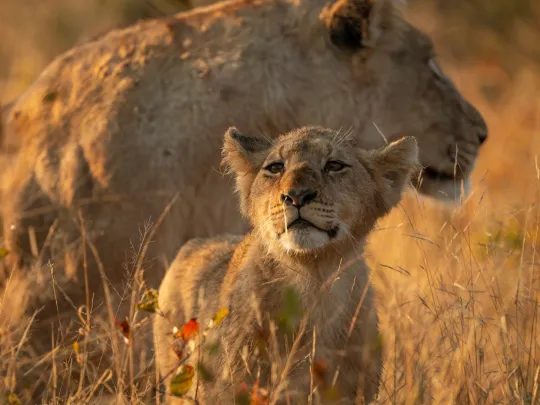
Kruger Safaris June 2021 Highlights
Winter is generally one of the best times to go on safari in Kruger. And this year was no exception! The days were sunny and warm, the dry bush made it easy to spot game and the wildlife was prolific. Big Five, wild dog, cheetah and lion cub sightings were just some of the highlights from our June 2021 Kruger safaris.
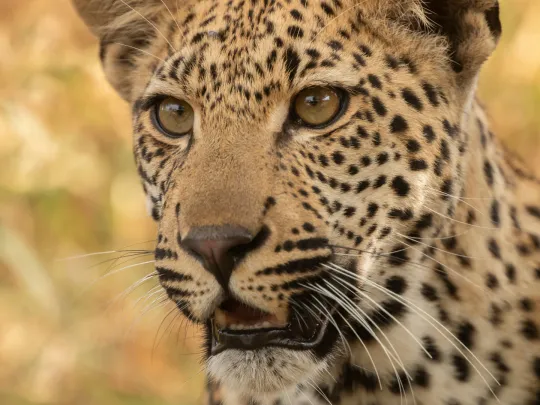
Kruger Safaris July 2021 Highlights
What does the South African version of a winter wonderland look like? For us, it's Kruger National Park in July. As the winter season wears on, more and more animals gather at rivers and waterholes to drink. Lion and hyena cubs, hippo, elephant, buffalo and rhino calves and a honey badger on a night raid count amongst our favourite sightings from our July 2021 Kruger safaris.

Best Time to Visit Kruger National Park? The Secret Month Revealed!
Most safari guides will tell you that the best time to visit Kruger National Park is during the dry season (June to September). And while that's mostly true, there's a little-known secret among Kruger enthusiasts.
About the author

A 'word smith' or copywriter with over 25 years experience, love travelling, wildlife and conservation; fascinated by alternative energy, alternative building and alternative health. Consummate reader and traveller, both internationally and southern Africa. Have two remarkable daughters that continue to amaze and teach me daily. Consider myself privileged to live on the best continent on the planet.









